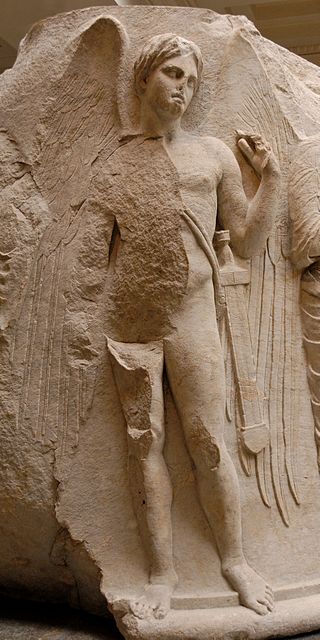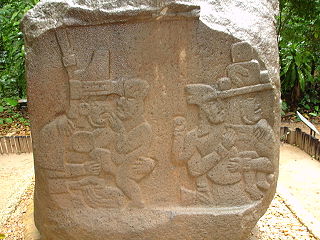Related Research Articles

Heracles, born Alcaeus or Alcides, was a divine hero in Greek mythology, the son of Zeus and Alcmene, and the foster son of Amphitryon. He was a descendant and half-brother of Perseus. He was the greatest of the Greek heroes, the ancestor of royal clans who claimed to be Heracleidae (Ἡρακλεῖδαι), and a champion of the Olympian order against chthonic monsters. In Rome and the modern West, he is known as Hercules, with whom the later Roman emperors, in particular Commodus and Maximian, often identified themselves. Details of his cult were adapted to Rome as well.

Theseus was a divine hero and the founder of Athens from Greek mythology. The myths surrounding Theseus, his journeys, exploits, and friends, have provided material for storytelling throughout the ages.

In Greek mythology and later art, the name Hesione refers to various mythological figures, of whom the Trojan princess Hesione is most known.

In Greek mythology, Thanatos was the personification of death. He was a minor figure in Greek mythology, often referred to but rarely appearing in person.

In Greek mythology, Perseus is the legendary founder of the Perseid dynasty. He was, alongside Cadmus and Bellerophon, the greatest Greek hero and slayer of monsters before the days of Heracles. He beheaded the Gorgon Medusa for Polydectes and saved Andromeda from the sea monster Cetus. He was the son of Zeus and the mortal Danaë, as well as the half-brother and great-grandfather of Heracles.

The Maya Hero Twins are the central figures of a narrative included within the colonial Kʼicheʼ document called Popol Vuh, and constituting the oldest Maya myth to have been preserved in its entirety. Called Hunahpu and Xbalanque in the Kʼicheʼ language, the Twins have also been identified in the art of the Classic Mayas. The twins are often portrayed as complementary forces.

Twins appear in the mythologies of many cultures around the world. In some cultures they are seen as ominous, and in others they are seen as auspicious. Twins in mythology are often cast as two halves of the same whole, sharing a bond deeper than that of ordinary siblings, or seen as fierce rivals. They can be seen as representations of a dualistic worldview. They can represent another aspect of the self, a doppelgänger, or a shadow. However, twins can also reflect a complete opposition of the other, such as the "civilized" Gilgamesh, and the "wild" Enkidu; or in the commonly known instance of good and evil twin identities.

The Changing People, dubbed the Deviants by the Eternals, are a fictional race of humanoids appearing in American comic books published by Marvel Comics.

Welsh mythology consists of both folk traditions developed in Wales, and traditions developed by the Celtic Britons elsewhere before the end of the first millennium. As in most of the predominantly oral societies Celtic mythology and history were recorded orally by specialists such as druids. This oral record has been lost or altered as a result of outside contact and invasion over the years. Much of this altered mythology and history is preserved in medieval Welsh manuscripts, which include the Red Book of Hergest, the White Book of Rhydderch, the Book of Aneirin and the Book of Taliesin. Other works connected to Welsh mythology include the ninth-century Latin historical compilation Historia Brittonum and Geoffrey of Monmouth's twelfth-century Latin chronicle Historia Regum Britanniae, as well as later folklore, such as the materials collected in The Welsh Fairy Book by William Jenkyn Thomas (1908).

In Hinduism, Kali is the being who reigns during the age of the Kali Yuga and acts as the nemesis of Kalki, the tenth and final avatar of the Hindu preserver deity, Vishnu.

The Sea-Maiden is a Scottish fairy tale collected by John Francis Campbell in Popular Tales of the West Highlands, listing his informant as John Mackenzie, fisherman, near Inverary. Joseph Jacobs included it in Celtic Fairy Tales.

The Titan's Curse is an American fantasy-adventure novel based on Greek mythology written by Rick Riordan. It was released on May 1, 2007, and is the third novel in the Percy Jackson & the Olympians series and the sequel to The Sea of Monsters. It is about the adventures of the 14-year-old demigod Percy Jackson as he and his friends go on a dangerous quest to rescue his 14-year-old demigod friend Annabeth Chase and the Greek goddess Artemis, who have both been kidnapped by the titans.
Kabundungdulu is the twin brother of Sudika-mbambi and is an Ambundu mythological figure. He is part of an origin myth for thunderstorm, where he represents the sound of a thunder’s echo.
Kimanaueze, sometimes referred to as Na Kimanaueze or Na Kimanaueze Kia-Tumb’a Ndala, is a culture hero figure in Ambundu or Mbundu mythology whose people are mostly based in Angola at present. The name Kimanaueze can be used to refer to either the hero who married the daughter of the Sun and the Moon, as well as the father of said hero. The younger Kimanaueze is the father of another Ambundu culture hero, Sudika-mbambi, and his brother, Kabundungdulu.

The Hero Twins are recurring characters from the mythologies of the indigenous peoples of the Americas. The specifics of each myth vary from tribe to tribe, but each story has a pair of twins who were born when their pregnant mother was killed by the tale's antagonist. Twins were considered unnatural in many cultures of this region, with beliefs about them having supernatural abilities.
References
- 1 2 3 4 5 6 Lynch, Patricia Ann; Roberts, Jeremy (2010). African Mythology, A to Z. Infobase Publishing. ISBN 978-1-4381-3133-7.
- 1 2 "Sudika-Mbambi Descends to Earth". Oxford Reference. Retrieved 2021-02-09.
- ↑ MacCulloch, John Arnott (1964). The Mythology of All Races: Indian. Cooper Square Publishers.
- ↑ "Entry details | Our Mythical Childhood Survey". www.omc.obta.al.uw.edu.pl. Retrieved 2021-02-09.